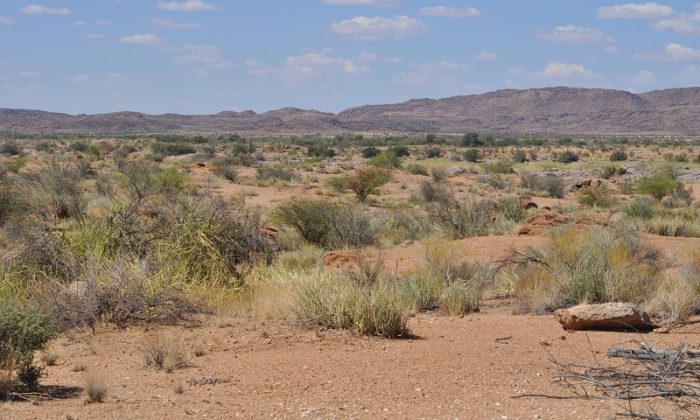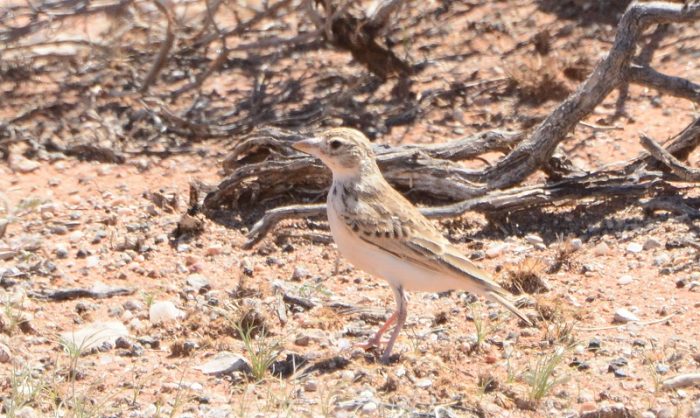Cover image: Stark’s Lark by Zenobia van Dyk – Near Poffadder, Northern Cape – BirdPix No. 245207 Stark’s Lark
Identification
Stark’s Lark is a small species with a more elongate and slender build than other small larks. It is very pale and appears white from a distance. The legs are fairly long and spindly and the head appears large due to its crest and stout beak.

Photo by Alan Collett
Stark’s Larks is sandy, grey-brown above with dark streaks. It is almost completely white below with indistinct streaks on the breast. The throat is white and the face is pale and relatively unmarked. The crown is streaked and can be raised into a long, shaggy crest. The tail is relatively long and has a dark middle with white outer tail feathers.
The beak is pinkish-grey and is stout and heavy with a curved upper mandible.
The sexes are alike.
Juveniles have whitish tips to the feathers on the crown, back and wings.

Photo by Katharina Reddig
Status and Distribution
Stark’s lark is near-endemic to southern Africa. It is distributed from the Northern Cape in South Africa, up through Namibia and into south-western Angola. It can be locally common but is highly nomadic and its abundance and range is largely determined by rainfall.

Details for map interpretation can be found here.
Habitat

Augrabies Falls National Park, Northern Cape
Photo by Ryan Tippett
Stark’s Lark is a species of arid and semi-arid open plains, with sparse perennial grasses and Karoo shrubs on sands. It favours sites where there are patches of calcrete or scattered pale quartz or calcrete pebbles. It also occurs in open, arid savanna in the Southern Kalahari and on the edge of the Namib Desert where it is found on sparsely vegetated gravel plains.

Kenhardt District, Northern Cape
Photo by Ryan Tippett
Behaviour
Stark’s Larks are found in pairs when breeding. When not breeding they occur in flocks of several individuals up to a few hundred or even thousands of birds, which congregate in areas of fresh green grass after rains. They often occur alongside Grey-backed Sparrow-Larks and Lark-like Buntings. They appear able to survive without drinking water but they will drink regularly during the dry season if water is available. Drinks less often after rains have greened vegetation and increased insect availability. They fly to waterpoints in flocks. Avoids heat stress during the mid-day heat by crouching in shade. Occasionally perches on a low shrub or rock, facing into the breeze while holding its wings away from the body to cool down.
Forages by walking slowly on flexed legs, with its body close to ground, pecking items from off the floor. Feeds primarily on seeds from various grasses and shrubs. Arthropods also form an important part of the diet and include Harvester Termites, ants, beetles, bugs, flies, spiders etc. Also feeds on green plant material, especially the fresh base of grass stems.

Photo by J. Terblanche
Males start singing and displaying after rainfall has stimulated breeding activity. It sings from the ground, from a low shrub or in flight display. During display the male rises between 50 m to 200 m above the ground while hovering or flying in slow circles, calling constantly.
Stark’s Lark is a monogamous, solitary nester, often in loose colonies. This species breeds opportunistically after rain and breeding may take place whenever sufficient rain has fallen. There is however a breeding peak from March to May after late summer rains.
The nest is a neat cup composed of fine strips of grass, built into a slight depression in the soil. It is usually placed at the base of a plant or stone but sometimes also in exposed positions. The nest normally faces south or south-east for shade on hot days.
Clutches consist of two or three eggs and incubation takes 11 to 13 days. The eggs are incubated by both sexes. The nestling period lasts for around 10 days during which time the chicks are fed by both parents.

Photo by Michael Houlden
Further Resources
Species text adapted from the first Southern African Bird Atlas Project (SABAP1), 1997.
The use of photographs by Alan Collett, Gregg Darling, J Terblanche, Katharina Reddig, Michael Houlden and Zenobia van Dyk is acknowledged.
Virtual Museum (BirdPix > Search VM > By Scientific or Common Name).
Other common names: Spizocorys starki (Alternative Scientific Name); Woestynlewerik (Afrikaans); Alouette de Stark (French); Starks Kurzhaubenlerche (German); Cotovia de Stark (Portuguese)
Recommended citation format: Tippett RM 2023. Stark’s Lark (Eremalauda starki) Biodiversity and Development Institute. Available Online at http://thebdi.org/2023/02/13/starks-lark-eremalauda-starki/

Photo by Gregg Darling

